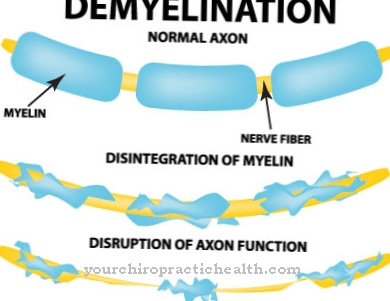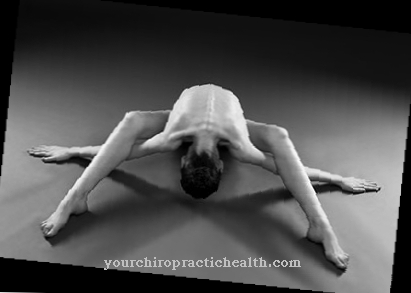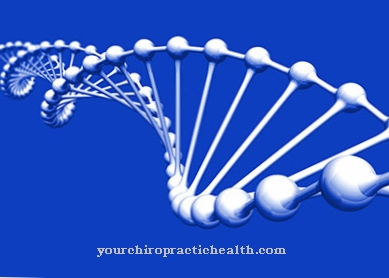The Oligomenorrhea is a cycle disorder (menstrual disorder) with various possible causes. Fighting the cause usually has a positive effect on oligomenorrhea.
What is oligomenorrhea?
.jpg)
© deagreez - stock.adobe.com
From one Oligomenorrhea According to the definition of the WHO (World Health Organization), it is when the overall female cycle is extended or when one is too short and weak menstrual cycle occurs. The opposite of this is menorrhagia (long and heavy menstrual bleeding).
A distinction can be made, among other things, between so-called primary and secondary oligomenorrhea: A primary oligomenorrhea is when an affected woman has had too rare or too short and weak menstrual periods since the first menstrual period (menarche).
In the case of secondary oligomenorrhea, the menstruation after the menarche initially corresponded to the norm and only over time did the menstrual period become too rare or too short and weak.
A cycle extension in oligomenorrhea can be a minimum of 35 days and a maximum of 90 days. Often, oligomenorrhea occurs at the beginning of puberty or at the beginning of menopause.
causes
Possible causes of a Oligomenorrhea are diverse. If oligomenorrhea occurs in the first time after menarche or before menopause, it can be an expression of the hormonal changes that take place in the female body.
But various diseases can also lead to oligomenorrhea. For example, there may be disorders that affect the function of the ovaries or hormonal diseases in which too much male hormones are produced.
Disorders of the thyroid function (both under and over functioning) or tumors such as uterine cancer can lead to oligomenorrhea. In addition, oligomenorrhea can be psychologically favored (for example due to high stress) and can also be the result of anorexia.
Last but not least, competitive sports can lead to oligomenorrhea in women.
Symptoms, ailments & signs
The main symptom of the disease is a rarely occurring menstrual period. In oligomenorrhea, the cycles are extended to 35 to 90 days. In rare cases, longer periods of time are possible. The affected women usually had normal cycles of about 24 to 30 days before the onset of oligomenorrhea.
Usually the bleeding is weaker and shorter than before. But they can also occur in the usual strength and duration. Very light bleeding and spotting is rare, but it can last for up to two weeks. Other menstrual disorders can occur in women affected by hormones. This can lead to intermenstrual bleeding or increased menstrual cramps.
Depending on the underlying disease and the cause of the oligomenorrhea, other symptoms may be present. If ovarian cysts or polycystic ovarian syndrome are also present, this can lead to severe weight gain and obesity. Increasing masculinization rarely occurs.
Those affected perceive increased body hair. Beard growth on the face and simultaneous loss of head hair can also occur. The clitoris rarely enlarges and muscle mass is increased. Oligomenorrhea is caused by an increased prolactin level, but a milky liquid is released from the breasts of those affected.
Diagnosis & course
Diagnosing causes of a Oligomenorrhea usually begins with a patient interview with the treating gynecologist; Patients are often asked about their medical history, which can often give the doctor information about possible causes of oligomenorrhea.
This is usually followed by a gynecological examination, during which the ovaries, uterus and vagina are palpated. In order to be able to diagnose the causes of oligomenorrhea, these examination steps are often supplemented by performing an ultrasound examination.
Blood tests can also be used to identify any hormonal disorders or other diseases that may have led to oligomenorrhea.
Most of the time, oligomenorrhea only shows the symptoms of a menstrual period that is too rare or too short and weak. Depending on the cause of oligomenorrhea, in individual cases, for example, obesity, fluid secretion from the breasts or excessive body hair can occur.
Complications
With this disease, those affected suffer from different complaints. The further course and treatment of this disease depend heavily on the underlying disease, so that no general course can be given. As a rule, however, the patients suffer from a very weak menstrual cycle, which, however, lasts for a long time.
Menstrual cycle disorders and strong mood swings occur. Depression or other mental illnesses can also occur due to illness and have a negative effect on the quality of life and also on the relationship with one's own partner. Those affected also suffer from cysts on the ovaries and in many cases from excessively thick hair. The hairiness can also lead to a reduced self-esteem or inferiority complexes.
In many cases, those affected feel uncomfortable and are ashamed of the symptoms. The woman's desire to have children may also not be fulfilled due to the disease. There are usually no complications with treatment. The symptoms can be alleviated with the help of hormones. In some cases, however, those affected are dependent on psychological therapy. However, life expectancy is not affected by the disease.
When should you go to the doctor?
In almost every case, oligomenorrhea indicates a hormonal problem or at least a change that will not normalize on its own. Therefore, every woman, regardless of age, should see a doctor if her menstrual period lasts short, is weak and occurs less often than usual. A harmless form of oligomenorrhea occurs in young girls immediately after menarche, although not in every girl. While a few girls can get their regular cycle right away, others take a cycle or two before they become regular. However, if the menstrual periods do not come as often as they should, then the gynecologist should be consulted.
Oligomenorrhea can usually also occur after pregnancy and childbirth, because even now the cycle must first normalize. Short-term oligomenorrhea also occurs after hormonal birth control is discontinued. These are all natural causes and not yet a reason to see a doctor.
Suddenly occurring oligomenorrhea, on the other hand, should be the reason for a check-up at the gynecologist, because if a woman had a normal cycle before and this changes, there is a reason. Middle-aged women could reach menopause. However, oligomenorrhea can also indicate hormonal imbalance, endocrinological disease, or a physical illness that needs to be detected in a timely manner.
Treatment & Therapy
Whether medical treatment of the Oligomenorrhea is necessary or useful depends primarily on the causes of oligomenorrhea:
If the menstrual period is too rare or too short and weak due to hormonal disorders and if an affected woman wants to have children, hormonal therapy methods can be used, for example. If an overactive or underactive thyroid has led to oligomenorrhea, this dysfunction can be counteracted, among other things, with drug treatment to combat oligomenorrhea.
Even if a tumor is the reason for an oligomenorrhea, successful tumor treatment can lead to the oligomenorrhea also regressing. Anorexia as a cause of oligomenorrhea is often treated with the help of combined treatment methods:
While nutrition-related rehabilitation therapy is often carried out, which is intended to help an affected woman achieve a normal weight, this therapy component is usually supplemented by individually tailored psychotherapy. With a successful course of therapy, the oligomenorrhea can also decrease as a result.
You can find your medication here
➔ Medicines for menstrual crampsOutlook & forecast
The prognosis for oligomenorrhea depends on which factors caused the menstrual disorder. If the short and weak menstrual period occurs in times of intense physical or emotional stress, the menstrual cycle often returns to its natural rhythm after the exhausting phase of life. Learning relaxation techniques and a healthy lifestyle with a balanced diet and adequate sleep can aid this process.
Oligomenorrhea that occurs in early puberty usually does not require treatment either and changes into a normal menstrual cycle as soon as the hormone production in the young woman's body has settled down. If the short and weak menstrual period is caused by a mental illness such as anorexia nervosa, the patient may need long-term psychotherapeutic care to stabilize the body and psyche.
Organically caused oligomenorrhea can often be completely eliminated through effective treatment of the underlying disease. If the thyroid gland is over or underactive, drugs are used, while ovarian dysfunction or tumors are usually treated surgically.If the poor menstrual period is caused by polycystic ovarian syndrome (PCOS), hormone therapy can help the maturation of egg cells and ovulation in women who are unable to have children. This treatment increases the chance of pregnancy significantly.
prevention
One can prevent it Oligomenorrhea initially by identifying and treating possible causal diseases at an early stage. Hormonal factors that can lead to oligomenorrhea can be positively influenced by various behavioral measures: For example, oligomenorrhea due to hormonal factors can be prevented by measures such as reducing stress, getting enough sleep, healthy nutrition, avoiding nicotine and avoiding being underweight and overweight .
Aftercare
In most cases, there are no special or direct follow-up measures available to those affected by oligomenorrhea, so that the person affected should usually consult a doctor early on in this disease. Most of the time, self-healing cannot occur either, so a visit to a doctor is always necessary for the patient.
The earlier a doctor is contacted, the better the further course of the disease will usually be. In most cases, oligomenorrhea is treated by taking various medications. It is important to ensure that the medication is taken regularly and that the dosage is correct in order to alleviate the symptoms over the long term.
If you have any questions, or if you have any side effects, you should also consult a doctor first. Most of those affected are also dependent on the support of their own family or their partner, which can also prevent depression or other psychological disorders. Oligomenorrhea does not reduce the life expectancy of the person affected.
You can do that yourself
If oligomenorrhea occurs during puberty or shortly before the menopause as a result of natural hormonal changes, this is usually not perceived as bothersome - treatment is therefore not necessary. If a woman's desire to have children cannot be fulfilled due to the menstrual disorder, she should measure her basal temperature for a certain period of time and keep a menstrual calendar: These records make it easier for the doctor to research the cause.
In addition to any medical treatment that may be necessary, some medicinal plants have proven themselves to be used against a too short and weak menstrual period: Monk's pepper should be mentioned here, which can compensate for hormonal disorders and stabilize the menstrual cycle when taken for a long time. In Far Eastern medicine, ginger and aloe vera are also used to stimulate menstruation. If the oligomenorrhea is due to stress or great mental stress, regular relaxation exercises such as autogenic training or yoga can have a balancing effect. In the case of physical overstrain, for example through excessive sporting activity, a reduction in the amount of training helps, cycle irregularities caused by underweight usually disappear after reaching normal weight.
If an eating disorder is the cause, psychotherapeutic treatment should be given. A healthy lifestyle with a balanced diet, a balanced relationship between activity and relaxation, and largely avoiding nicotine can also have a positive effect on the menstrual cycle.



.jpg)


.jpg)




















